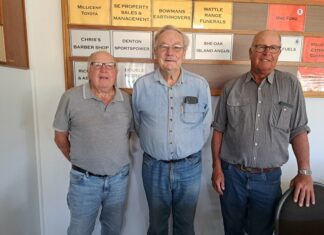While sitting buckled in to an aeroplane seat, an air hostess stood in the aisle with a bright yellow life vest draped over her.
A recorded voice told passengers what to do “in the unlikely event” of a crash.
As the recording continued, the hostess demonstrated how to inflate the vest and blow a whistle.
“I think we’ll need a bit more than that if the plane goes down,” joked the person sitting next to me.
With a fear of plane travel, I tried to smile.
The plane zoomed along the runway, then launched into the air and soon the pilot’s voice could be heard.
The ride was bumpy as there was “a bit of jet stream, but we’ll soon be through it”.
Opening a page titled “case studies” on his Ipad, the person next to me sensed I was anxious and asked where I was from.
He had heard of Mount Gambier, Robe and Naracoorte, but wasn’t sure where they were.
“Are they in Victoria?,” he asked.
Obviously he was from somewhere like Canberra.
Soon I learnt he was a highly qualified mental health professional.
“I work with adults who have mental health problems – all kinds of problems – schizophrenia, psychoses, bipolar disorder, addictions, severe depression and anxiety – pretty much everything.”
He said the drug known as “ice” was making his job more difficult than 10 years ago.
“I heard one psychiatrist the other day say he wished for a genuine heroin addict to walk through his door because he was sick of seeing ice addicts,” the gentleman said.
“When we get to see them, ice addicts are often aggressive, violent and pretty terrible to deal with or try to help – it’s a really horrible drug.”
According to the National Wastewater Drug Monitoring Program report released this month, Adelaide is officially the ice capital of Australia, while Western Australia has the highest rate of ice consumption in regional areas.
But across all regions, including the South East, methylamphetamine continues to be the highest consumed illicit drug.
Last year people smoked, snorted, swallowed or injected an estimated 8.3 tonnes of the stuff.
Testing for various drugs in South Australia included four wastewater sites around Adelaide, and five regional sites, of which one is believed to be Mount Gambier.
“There seems to be a lot of ice in regional communities, but few or no mental health facilities,” the person next to me said.
“You find a lot of mental health professionals end up leaving or not even going to regional areas because of the extra heavy workloads.”
And what did he see generally as the main cause of mental health issues, including drug or alcohol addiction?
“People are not coping,” he said.
“A lot of people just can’t cope with the things life throws at them.”
Bullying or bias in the workplace or through social media, lack of opportunity, unemployment, job loss, relationship breakdown, injury, moving homes, death of a loved one and illness were some of the more common difficulties some people struggled with.
Other distressing issues included the impact of domestic violence, murder, rape, gambling, drug abuse, accidents, crashes, fires and floods.
From basic manners and etiquette to learning about grief and loss, the best thing parents could teach their kids was “how to communicate and cope with a range of situations – there is always hope, even for ice addicts”.
“And people can learn how to get over their fear of flying as well,” he laughed.
Chris Oldfield can be contacted by email on christobel47@gmail.com





